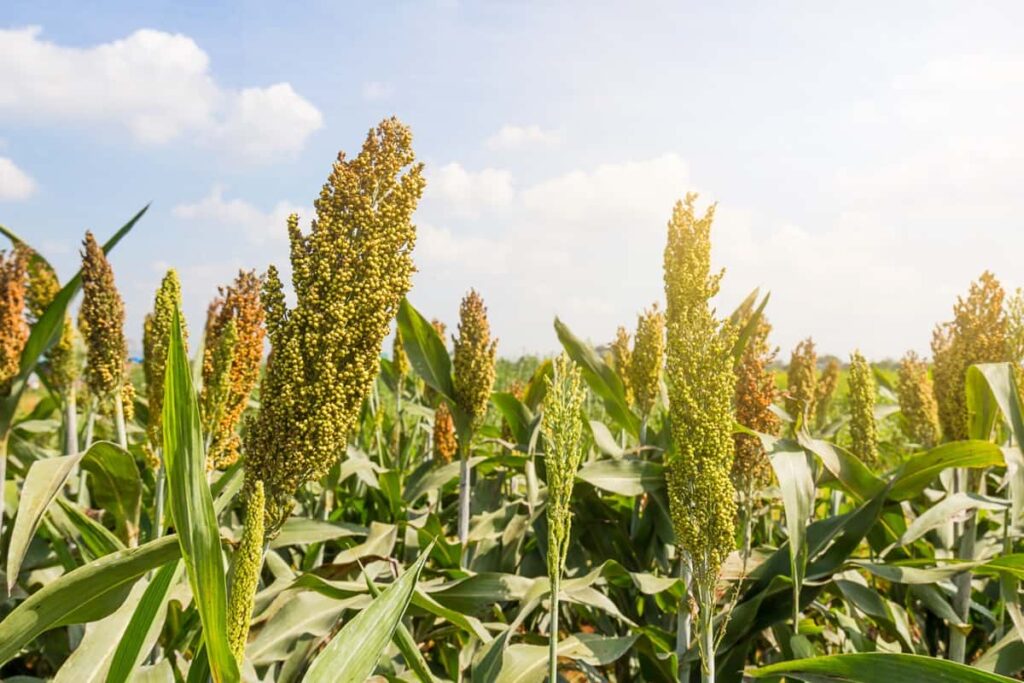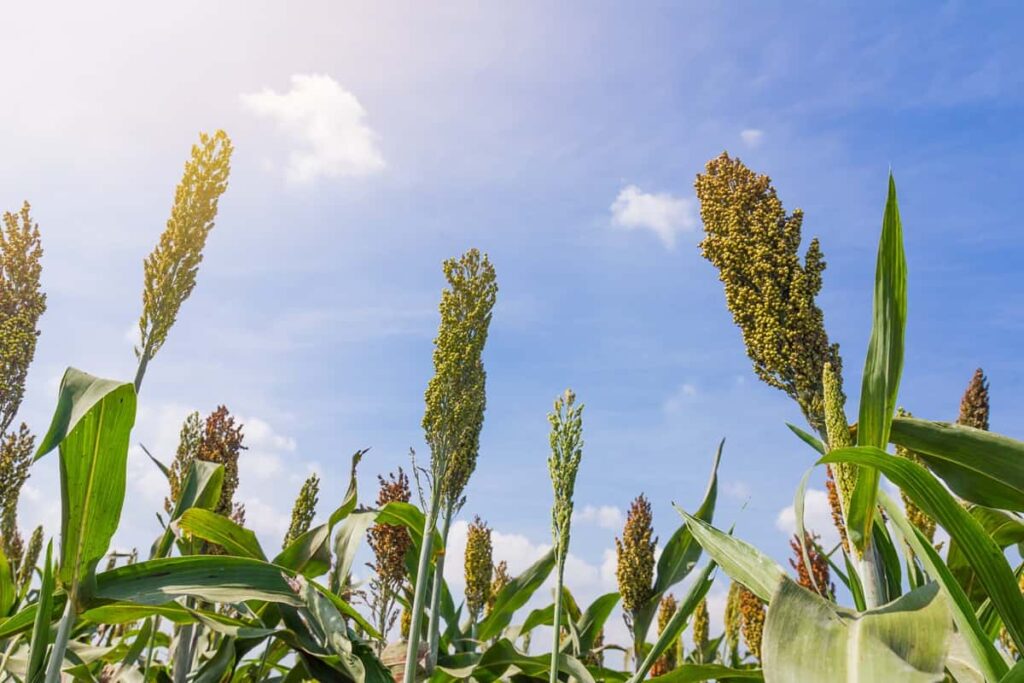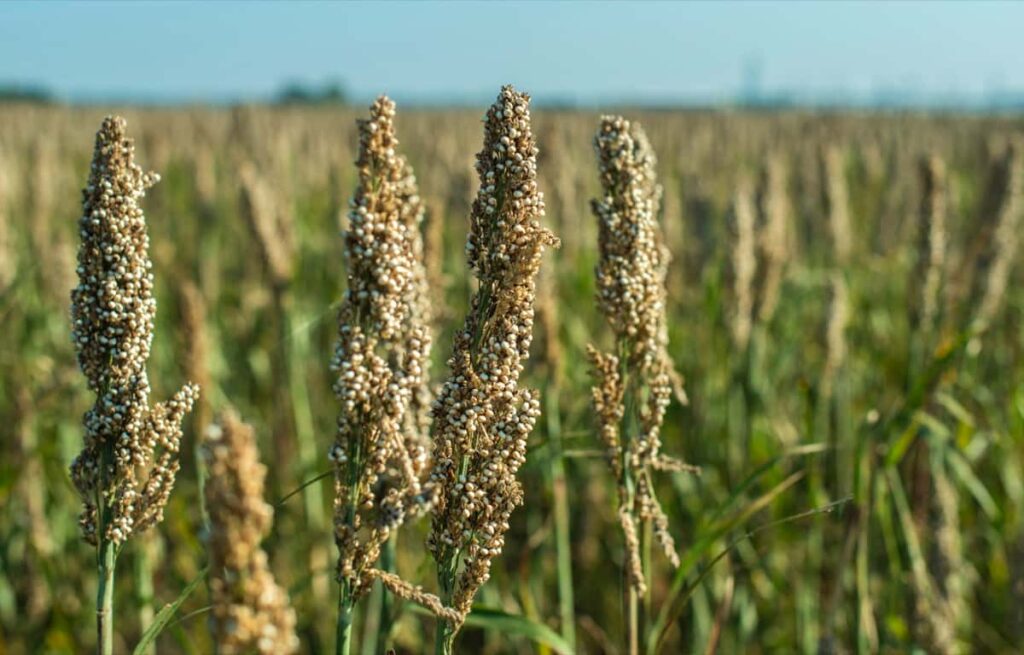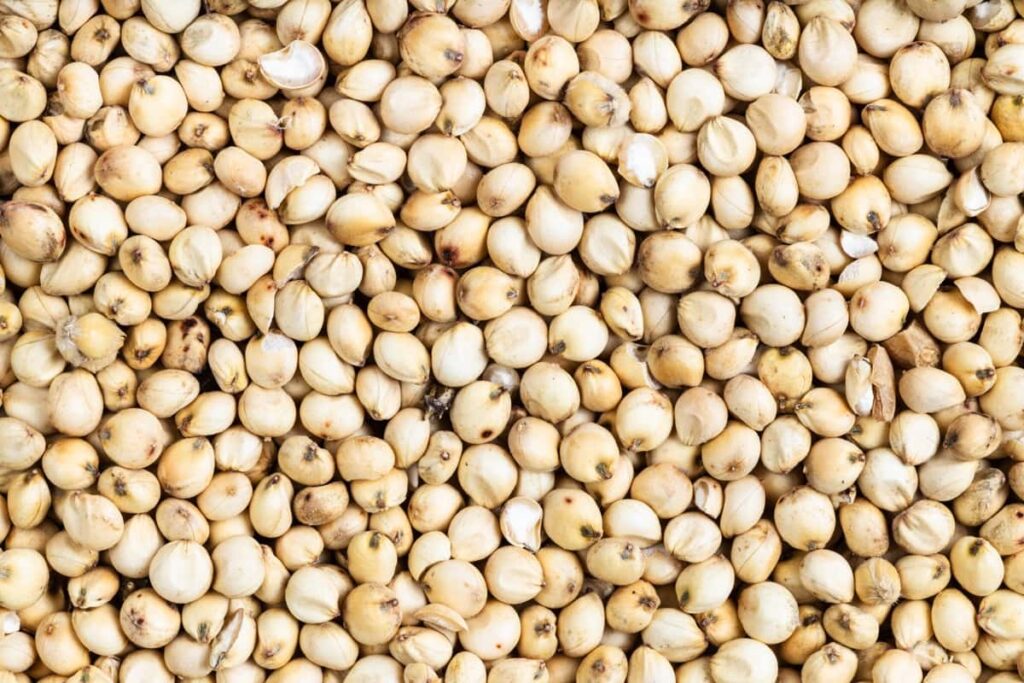Hello friends, are you planning to grow Sorghum in Indonesia? Well, you are landed in the right place. Sorghum is a drought-tolerant crop that is well-suited to the dryland conditions of Indonesia. Sorghum production in Indonesia has been increasing recently due to its high yield potential and versatility as a staple food, feed, and fuel crop. Indonesia is the world’s third-largest sorghum producer, behind only the United States and Nigeria.

Sorghum is mainly grown in the dryland areas of Indonesia, such as Kalimantan, Sulawesi, and Nusa Tenggara. Most Indonesian sorghum production is for animal feed (cattle/poultry), particularly for the country’s growing livestock sector. However, Sorghum can also be used as a food crop or for biofuel production. Sorghum can be a productive and profitable crop for Indonesian farmers with proper management and inputs. This article will cover seed sowing to harvesting Sorghum in Indonesia.
Sorghum farming in Indonesia
Varieties of Sorghum cultivated in Indonesia
Sorghum is a grain crop, and recently, the growth of this staple food crop has been gaining importance along with rice and corn. Many different types of Sorghum can be found in Indonesia, each with its unique flavor and use.
- The most common type of Sorghum in Indonesia is red Sorghum. This Sorghum makes various dishes, including stews, soups, and curries. Red Sorghum has a slightly sweet flavor and is often used in Indonesian cuisine to replace rice.
- Another common type of Sorghum in Indonesia is white Sorghum. White Sorghum is often used to make bread and cakes. It has a light, fluffy texture that makes it perfect for baking.
- Several varieties of wild Sorghum can be found in Indonesia.
In case you missed it: Guntur Red Chilli Farming Project Report: Production Cost, Market Analysis, and Cultivation Practices

Widely Sorghum cultivated areas in Indonesia
| Purwodadi | Bojonegoro |
| Pati | Tuban |
| Demak | Purbolinggo |
| Wonogiri | Yogyakarta |
| Lamongan | Nusa Tenggara (East and West) |
Climate and soil requirement for growing Sorghum in Indonesia
Sorghum is a hardy crop that can be grown in various climates and soil types. It is tolerant of high temperatures and dry conditions, making it an ideal crop for arid and semi-arid regions. Sorghum can be grown in various soils, but loamy, well-drained soils are best. Sandy loams or clay loams with a high organic matter content are ideal.
Sorghum requires moderate to high fertility and does best with full sun exposure. Sorghum can tolerate high temperatures up to 42°C. However, yield losses may occur at temperatures above 35°C. Sorghum is a short-day plant, and the length of the day affects its growth and development. The ideal soil pH for growing grain Sorghum is 6.0 to 7.5.
In case you missed it: Growing Potatoes Organically in Telangana: Step-by-Step Cultivation and Production

How to prepare the land for Sorghum production?
To ensure a successful sorghum crop, it is important to prepare the land well in advance. The first step is to clear the land of debris, branches, previous crop residues, rocks, or other obstructions that could impede plant growth. Once the land is cleared, it should be plowed and tilled to a depth of at least 8 inches. This will help to loosen the soil and allow for better root development.
After the land has been prepared, it is time to apply organic matter to the soil. This can be done by adding manure or compost. The other step in preparing the land for sorghum production is to create seedbeds. Seedbeds should be created by working the soil into small mounds or hills. This will help to ensure that the seeds are evenly distributed and have good contact with the soil. Finally, the land should be leveled off so that it is even. This will help to ensure that the sorghum plants have enough space to grow.
Propagation of Sorghum
If you plan to grow your Sorghum, you can propagate it from seed. It’s a relatively easy process, and it’s a great way to get started with growing your food. Here’s how to do it:
- Start by soaking your seeds in water for 24 hours. This will help them germinate more quickly.
- After soaking, plant the seeds in moist soil about 1/2 inch deep.
- Keep the soil moist, and wait for the seeds to germinate. This can take from a few days to a couple of weeks.
- Once the seedlings have emerged, thin them out and space them about 12 inches apart.
- Sorghum grows best in full sun, so make sure to give your plants plenty of sunlight.
Mulching importance in Sorghum cultivation and types of mulches
Mulching is an important step in sorghum cultivation/production. It helps reduce evaporation, regulate soil temperature, and prevent weed growth. A good mulch will also help improve the appearance of your sorghum crop. There are two main types of mulches: organic and inorganic.
- Organic mulches include straws, leaves, grass clippings, and wood chips.
- Inorganic mulches include things like black plastic, landscape fabric, and gravel.
In case you missed it: How to Create Productive Flower Garden: A Complete Guide for Beginners

When choosing a mulch for your sorghum crop, remember a few things. First, you’ll want to ensure that the mulch is permeable so that water can still reach the roots of the plants. Second, you’ll want to choose a mulch that will break down slowly over time, so you don’t have to replace it too often. And finally, you’ll want to ensure that the mulch you choose is appropriate for the climate in which you’re growing your Sorghum.
Planting process of Sorghum
Once the field is prepared, the seed should be planted at a depth of 1 to 2 inches and 4 inches apart. Sorghum seeds can be planted by hand or with a seed drill. After planting, the sorghum plants will need to be watered regularly. They should be kept moist but not too wet until they are established. Once established, sorghum plants are quite drought-tolerant. Weeds can compete with sorghum plants for water and nutrients, so keeping the area around the plants free of weeds is important. This can be done by hand-weeding or using herbicides.
Water management in Sorghum Crop
Water management in Sorghum is critical to the success of the crop. Sorghum is a drought-tolerant crop that still needs water to produce a good yield. There are several ways to manage water in sorghum production, including irrigation, drainage, and soil amendments. Irrigation is the most common method of water management in sorghum production.
Applying the right amount of water to the crop is important, as too much or too little can negatively impact yields. Drainage is also important in sorghum production, as it helps to remove excess water from the root zone and prevent flooding. Soil amendments, such as mulch, can also be used to help improve water retention in the soil and reduce evaporation. However, drip irrigation is the most preferred method for adequate water and fertilizer management in sorghum farming.
Best fertilizers/compost for Sorghum crop
Sorghum is a versatile crop used for livestock feed, human consumption, or biofuel production. The best fertilizers for Sorghum will vary depending on the specific use of the crop. For example, if the crop is grown for livestock feed, a fertilizer high in nitrogen will be needed. On the other hand, a fertilizer with higher phosphorus content will be required if the crop is grown for human consumption. No matter what the specific use of the sorghum crop is, all farmers should aim to use organic fertilizers whenever possible.
This is because organic fertilizers release nutrients slowly over time and are less likely to burn the plants. They are also more environmentally friendly than synthetic fertilizers. Some of the best organic fertilizers for Sorghum include compost, manure, and bone meal. These fertilizers should be applied to the soil before planting and then again during the growing season. Farmers should also keep the sorghum plants well-watered during dry periods.
Intercropping in Sorghum crop and why is it important?
Intercropping is the simultaneous cultivation of two or more crops in the same field. The main advantages of intercropping are increased yield, improved soil health, and reduced pest and disease pressure. For example, Sorghum is often grown as an intercrop with other cereals, soya beans, fodder cow peas, groundnut/peanut, and legumes. Intercropping Sorghum with other crops can increase yields by up to 50%. The main benefits of intercropping Sorghum are:
- Improved soil health: Sorghum has deep roots that help to break up compacted soils and improve drainage. This helps other crops to grow better too.
- Reduced pest and disease pressure: Pests and diseases often attack monoculture (single crop) fields more readily than fields where multiple crops are grown. This is because pests and diseases can build up quickly in monoculture fields but are less able to do so in fields with diverse crops.
- Increased yield: Intercropping can increase yields by up to 50%. This is because the different crops grown together can complement each other, for example, by using different depths of rooting systems to access water and nutrients from different depths in the soil. They are planting Sorghum in paired rows of 30 cm: 90 cm with 2 rows of intercrop in the 90 cm space, yielding maximum sorghum grains and intercrops.
In case you missed it: Genetically Modified Organisms in Agriculture: GMOs Uses and Benefits in Modern Farming

Weed management in Sorghum
Weed management is a critical component of successful sorghum production. Weed competition can reduce sorghum yield by up to 40 to 50%. Therefore, it is important to implement an effective weed management program to achieve optimal production. Several different weed management strategies can be used in sorghum production.
Cultural methods, such as crop rotation and cover crops, can effectively reduce the establishment of weeds. Mechanical methods, such as tillage and herbicide application, can also control weeds. The most effective weed management programs will likely utilize a combination of these different strategies. By using an Integrated Weed Management approach, growers can minimize the impact of weeds while maximizing sorghum production.
Disease management in Sorghum
Disease management is an important part of sorghum production. The most common diseases of Sorghum are leaf spots, rust, and smut. These diseases can cause significant losses in yield and quality. Several different fungi cause leaf spots. Symptoms include small, dark spots on the leaves. Leaf spots can be controlled with fungicides.
Rust is caused by a fungus that attacks the leaves of the plant. Rust symptoms include small, orange-red spots on the leaves. Rust can be controlled with fungicides. Smut is caused by a fungus that attacks the kernels of the plant. Smut symptoms include dark, sooty masses on the kernels. Smut can be controlled with fungicides or by planting resistant varieties.
Pest management in Sorghum
Pest management in Sorghum ensures a good yield and quality grain. Several pests, including aphids, armyworms, and stem borers, can affect Sorghum. Aphids are small insects that can cause stunted growth and reduced yields. They are typically controlled with insecticidal sprays. Armyworms are destructive caterpillars that feed on the leaves of sorghum plants.
They can cause extensive damage if left unchecked. Armyworms are typically controlled with biological controls or insecticides. Stem borers are another type of caterpillar that feeds on the stem of the sorghum plant. This can lead to reduced yields and lower-quality grain. Stem borers are typically controlled with insecticidal sprays or traps.
Harvesting and storage of Sorghum grains
Sorghum is a grain crop harvested and stored using similar methods to those used for other grains. The main difference is in the harvest timing, as Sorghum is a summer crop. The sorghum plant matures when the stems are dry, and the seeds are hard.
At this point, the plants are cut down using a combine harvester or by hand. The plants are then gathered into bundles and left to dry for a few days. Once the plants are dry, they are threshed to remove the seeds from the stalks. Again, this can be done by machine or by hand. The seeds are then cleaned, sorted, and stored in a cool, dry place until needed.
Expected yield of Sorghum per Hectare/Acre
Sorghum yield depends on many factors, such as variety, cultivation practices, and pest and disease management. For example, if you are growing Sorghum for a green fodder crop, the average yield per hectare would be around 500 quintals (Dry fodder would be around 75 to 100 quintals). However, if you are growing Sorghum for grain purposes, you can expect an average yield of 9 quintals per hectare or 3.5 quintals per acre.
In case you missed it: Pomegranate Fruit Fly: Symptoms, Treatment, Effective Management, Chemical, and Organic Control

Conclusion
Sorghum is a versatile and adaptable crop that can be grown in many environments. Indonesia’s long tradition of growing Sorghum remains an important part of the agricultural landscape. With proper management, Sorghum can be a productive and profitable crop in Indonesia. So, what are you waiting for? Start growing this wonderful grain.
- Profitable Village Farming Business Ideas in 2024
- High-Yield Aquaculture: Fast-Growing Fish for Farming
- Effective Fish Pond Construction Techniques for Beginners
- Irrigation and Water Management in Pineapple Farming
- Blossom to Harvest: Mastering Flowering and Pollination in Papaya Farming
- Pig Fattening Essentials: From Selection to Sale for Beginners
- Raising Wagyu Cattle: A Complete Guide for Premium Beef Production
- Soil Types and Their Water Holding Capacity
- Optimizing Irrigation Schedules for Coconut Groves for Enhanced Yield
- Espresso Your Garden: Coffee Grounds for Healthier Acid-Loving Plants
- The Best Soil Mix for Snake Plants: How to Mix Your Own Snake Plant Soil
- Green Thumb Success: Expert Tips for Cultivating Greenhouse Beans All Year Round
- Bloom All Year Round: The Ultimate Guide to Indoor Hyacinth Care
- Eco-Friendly Gardening: How to Make Liquid Fertilizer from Kitchen Waste
- Ultimate Guide to Grow Anise in Pots: Explore Seed Propagation to Harvesting
- Guide to Raising Chester White Pigs: Discover Breed Facts to Growth Management
- Mastering the Elegance: The Ultimate Guide to Weeping Cherry Tree Care, Planting, and Maintenance
- Ultimate Guide to Planting Garlic in Grow Bags: Growing Strategies for Beginners
- How to Fix Spider Plant Leaf-Related Problems: Natural and Organic Remedies
- 10 Reasons Why Your Tulsi Plant is Shedding Leaves: Home Remedies and Solutions
- Optimizing Growth and Yield: The Advantages of Palm Bunch Ash Fertilizer
- Utilizing Neem Oil Extract as a Natural Pesticide for Hydrangea
- From Soil to Harvest: Various Ways in Which Farmers Can Use AI Tools
- Steps to Encourage and Induce Citrus Flowers: A Comprehensive Guide
- How to Fix Snake Plant Leaf-Related Issues: Natural and Organic Remedies
- Transform Your Garden into a Fragrant Oasis with Raat Ki Rani (Night Blooming Jasmine)
- Discover the Ideal Chicken Breeds for Philippine Farms
- How to Create a Poultry Egg Farm Business Plan for Profits
- Grow Lemon Cucumbers Like a Pro: Insider Techniques for Bountiful Yields
- Ultimate Guide to Caring for Your Pink Princess Philodendron: Tips for Thriving Variegation
- Areca Nut Profit Per Acre: Calculating Yield and Cost of Cultivation
- How Kaveri Chicken is Becoming a More Profitable Breed in Indian Backyards
- Transform Your Barn: 9 Steps to Convert a Horse Stall into a Chicken Coop
- Exploring Suffolk Sheep Disadvantages with Limitations and Challenges
- Guide to Solving Potted Lemon Tree Problems: How to Revive Lemon Tree in Containers
- Steps to Encourage Female Pumpkin Flowers: Best Strategies for More Flowers and High Yields
